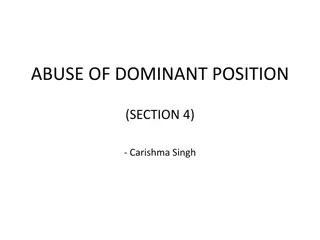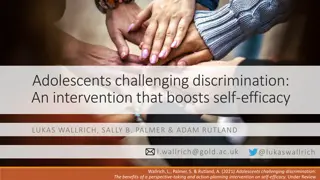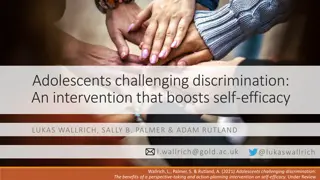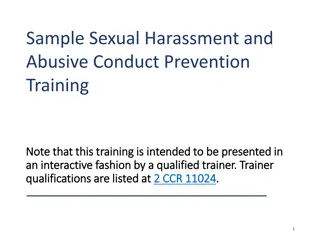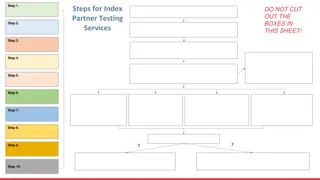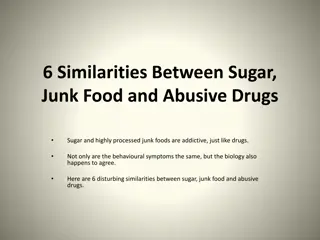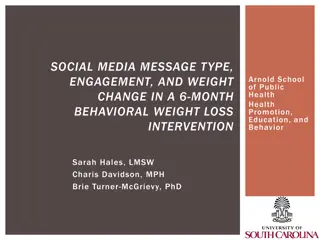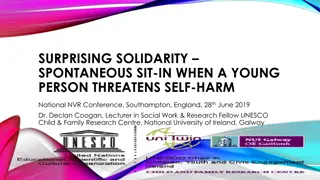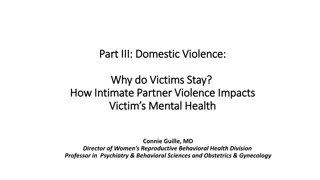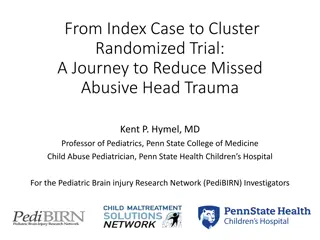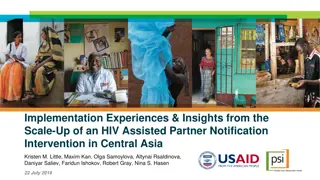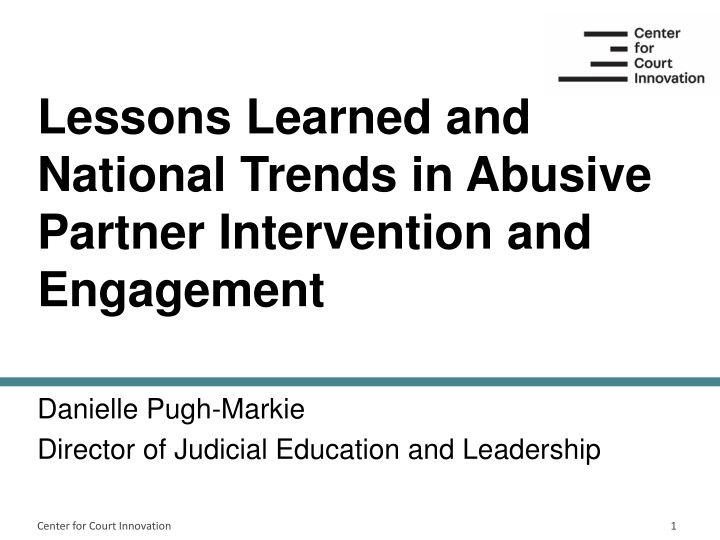
National Trends in Abusive Partner Intervention and Engagement
Explore lessons and national trends in addressing abusive partner behavior with insights from Danielle Pugh-Markie, the Director of Judicial Education and Leadership at the Center for Court Innovation.
Download Presentation

Please find below an Image/Link to download the presentation.
The content on the website is provided AS IS for your information and personal use only. It may not be sold, licensed, or shared on other websites without obtaining consent from the author. If you encounter any issues during the download, it is possible that the publisher has removed the file from their server.
You are allowed to download the files provided on this website for personal or commercial use, subject to the condition that they are used lawfully. All files are the property of their respective owners.
The content on the website is provided AS IS for your information and personal use only. It may not be sold, licensed, or shared on other websites without obtaining consent from the author.
E N D
Presentation Transcript
Lessons Learned and National Trends in Abusive Partner Intervention and Engagement Danielle Pugh-Markie Director of Judicial Education and Leadership Center for Court Innovation 1
Center for Court Innovation Center for Court Innovation 2
Gender and Family Justice & Research Practice Strategies Strategic Planning Needs Assessments Site Visits Targeted Training Evaluation 3 Center for Court Innovation
Learning Objectives Describe research around abusive partner intervention programming history, trends, innovations Introduce guiding principles for abusive partner intervention work Identify strategies for engaging fathers who have been abusive Center for Court Innovation 4
Where do abusive partner intervention programs fit in to Accountability, Intervention and Engagement? Center for Court Innovation 5
The Rise of Batterer Programs Origin Late 1970s response to lack of sentencing options in domestic violence (DV) cases (Pence and McMahon 1997) One prong in a coordinated community response (Pence and McDonnell 1999) Proliferation More than 2,200 programs nationwide in 2007 (Labriola et al. 2007) Required by many states (e.g., CA, FL, RI, and OR) for certain DV offenders (e.g. Austin and Dankwort 1999; Labriola et al. 2007) About 80% of participants court- ordered (Bennett & Williams 2004) Center for Court Innovation 6
Simultaneous Developments Increased funding for victim services Rise of pro-arrest policies More aggressive prosecution strategies Greater use of protection orders Intensive probation Pre- and post-disposition judicial monitoring Specialized domestic violence courts Center for Court Innovation 7
Major Program Models Educational Cognitive-behavioral Couples (individual or group format) Culturally-specific Restorative Justice/ Circles of Peace Accountability Center for Court Innovation 8
Cognitive Behavioral Therapy Key Elements: The Present: current people, places, and behaviors Thinking Errors: legal cynicism, external locus of control, sense of hopelessness, sense of victimization Cognitive Restructuring: effort to disrupt the automatic thoughts & feelings that lead to (e.g.) violence Address Lack of Empathy: effort to show connection between actions and hurtful effects on others Focus on Decision-Making: train to avoid impulsive reactions; use nonviolent communication Multiple Needs: Adaptable to many needs Center for Court Innovation 9
Key Goals of Batterer Programs Recidivism Reduction: Reduce violence: Rehabilitation: Change internalized thoughts, attitudes, and decision-making strategies Deterrence: Increase the costs of noncompliance Accountability: Serve as relevant sanction when jail is not an option (e.g., vs. fine or nothing). Implies: High program completion rate; and/or Use of jail or other sanctions for noncompliance Social Change: Directly or indirectly influence norms related to domestic violence (e.g., Men Stopping Violence) Center for Court Innovation 10
Common Program Goals (Cont.) Source: Labriola, Rempel, O Sullivan, Frank, et al. (2007). Center for Court Innovation 11
Focus of Curricula Center for Court Innovation 12
What Does the Research Say about Effectiveness? Center for Court Innovation 13
What were researchers measuring? Changed Attitudes or Beliefs Reduction in Re-Arrests or DV Re-Arrests Reduction in Victim Reports of Re-Abuse
Three Types of Research Designs Randomized Controlled Trial (RCT) or Experiment: Study subjects are randomly assigned; those in each condition will be comparable at baseline. Quasi-Experiment: Program participants are contrasted with naturally occurring comparison group; statistical methods increase comparability. Non-Experiment: No comparison group. Often, completers compared to dropouts; not a rigorous test, since completers are more predisposed to compliance.
Overview of Findings More than 60 batterer program evaluations Early Research (mostly 1980s and 1990s): Generally report high success rates Nearly all non-experiments without a comparison group Minimum Standards of Rigor(see Feder and Wilson 2005; Miller et al. 2013) Four Quasi-Experiments: 1 reduction, 1 increase, and 2 no- effects on re-arrest (Dutton 1986; Harrell 1991; Chen et al. 1989; Gordon & Moriarity 2003) Five Experiments: 1 reduction, 1 mixed, and 3 no effects Models: All psycho-educational or cognitive-behavioral
Research: Takeaways At present, effectiveness results are mixed. One can candidly convey this conclusion without discounting that effective programs may work. To pursue changed behaviors, thoughts and beliefs: either high-quality cognitive-behavioral approaches or other models with a proven evidence base are essential. Implementation factors may be critical (as they generally are in research on other populations).
Survivor Feedback Impact on Satisfaction (Bronx Study): Victims whose cases were assigned to a batterer program were more satisfied with the sentence (77%) than those whose cases were not assigned to a program (52%) Reasons for Dissatisfaction: 49% because outcome not harsh enough 30% because offender did not receive a treatment program 9% because outcome too harsh 12% for other reasons Source: Labriola et al. (2008). Center for Court Innovation 18
Whats happening nationally and locally with APIPs? Center for Court Innovation 19
National Innovations Risk Needs Responsivity Trauma-Informed Care Use of Hope Science Intersectionality Community Impact Center for Court Innovation 20
Risk Needs Responsivity Comprehensive assessment with validated risk tool Programming that addresses multiple needs Separation by risk level Fidelity to model and training CBT programming with structured delivery Center for Court Innovation 21
Adverse Childhood Experiences Personal & Household Adversities (Conventional ACEs) Community Adversities (Expanded ACEs) Physical abuse Substance using household member Emotional abuse Mentally ill household member Witnessed domestic violence Sexual abuse Incarcerated household member Emotional neglect Physical neglect Parents divorced or separated Witnessed violence Felt discrimination Unsafe neighborhood Experienced bullying Lived in foster care Center for Court Innovation 22
Trauma-Informed Strategies Comprehensive assessment including adversity assessment or trauma screen Trauma-informed interviewing techniques (e.g., motivational interviewing) Person-centered, strengths-based treatments based on needs (i.e., not one-size-fits-all approach) Incorporate mindfulness (e.g., breathing exercises) and coping strategies to manage emotional and behavioral responses to triggers Facilitators must understand, recognize, and respond to the effects of trauma; create a safe environment, build trust, and demonstrate authentic partnership (Voith et al., 2019) Center for Court Innovation 23
Assessing for Hope Recent research on men in an abusive partner intervention program in Baltimore found that No hope for the future was the greatest contributor to IPV perpetration. (Holliday et al., 2018) More than 2,000 studies have been published on the psychology of hope, and they all show that hope is the single best predictor of well-being (Hope Rising, 2019). Dignity & Respect program goal is to increase participants hope. Center for Court Innovation 24
Hope Scale WAYPOWER GOALS WILLPOWER
Example from NYC Seeding Generations Need for multiple pathways and programs Fostering an environment where participant has own stake in accountability, growth, community connection, and liberation Ensuring services operate in connection to survivors and/or survivor advocacy to further accountability and safety Holding space for trauma-informed behavioral change over time with a focus on transformative Healing in order to repair harm and interrupt generations of violence including historical oppressions and generational trauma Integrating differential and risk assessments to align safety considerations with interventions responsive to each individual causing harm Enabling case management and wrap-around services to support and maintain behavioral change Center for Court Innovation 26
Dignity and Respect Curriculum Definition of Dignity Compehensive Intake, including ACES, HOPE and Risk 16 or 26 weeks Spheres of Influence and Why We do What We Do CBT with motivational interviewing, trauma-informed Center for Court Innovation 27
Abusive Partner Accountability and Engagement Training & TA Funded by OVW Holistic, trauma-informed civil and criminal responses System-wide responses that are correlated to evidence-based best practices of risk, need, and responsivity of offenders Addressing sustainability, support, and training for programs and community partners to enhance a holistic, coordinated response Holistic responses to female defendants, LGBTQG defendants, youthful offenders, fathering after violence programs, and culturally specific programming Center for Court Innovation 28
Our Partners Futures Without Violence Expert Consultants: Alma Center Hon. Berryl Anderson Dekalb Magistrate Court Cheryl Davis Consultant James Henderson Alliance for Hope Men Stopping Violence Sojourner Family Peace Center Wica Agli Center for Court Innovation 29
Guiding Principles for Intervention and Engagement Accountability is active and relational Survivor voices are centered Restores hope and dignity Reflects and values culture and community Responsive to needs and strengths Center for Court Innovation 30
What would it mean to expand the definition of Accountability to include: Creating relational pathways to responsibility, healing and hope for one's self, others and one's community Center for Court Innovation
Think, Pair, Share: By yourself, then with a partner, then with your table discussion: How would this definition change the way I see: My role in accountability? The role of programs? How we define success? Center for Court Innovation 32
Abusive Partner Accountability and Engagement Training & TA Webinars National clearinghouse Training institutes On-site training and TA Screen Clipping Screen Clipping Center for Court Innovation 33
Contact Us Email us at dvaccountability@courtinnovation.org Visit us and join our listserv at dvcourts.org Center for Court Innovation 34



